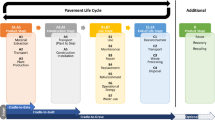Abstract
The exclusive effects of microsurfacing on thermal cracks were quantified in terms of IRI. In addition, vehicle operating costs related to the IRI were estimated. For the MnROAD project, using a measurement device with high resolution, pavement surfaces with thermal cracks were profiled before and after microsurfacing. The crack profiles were transferred into longitudinal profiles with no cracks so that the exclusive contribution of original and microsurfaced cracks to roughness could be analyzed. Then, vehicle operating costs corresponding to the exclusive roughness were evaluated. Applying the given amount of microsurfacing materials, the IRI resulting from cracks with 0.7 cm depth and 0.58 m width was reduced by about 80 percent for serviceable roughness levels. The IRI resulting from cracks with 1.5 cm depth and 0.61 m, and 1.8 cm depth and 0.80 m width were decreased by about 60 percent and about 45 percent, respectively. By examining vehicle operating costs, it was found that a small difference in crack severities results in a greater increase in cost. Therefore, it was concluded that prompt operation of microsurfacing for any crack severity levels is no less important than earlier operation for low severity cracks. In addition, it was concluded that microsurfacing can be a cost-effective maintenance technique for cracks for a year. If more than 3 cracks would be detected in the field, microsurfacing would be still a cost-effective maintenance method for any severity crack level.
Similar content being viewed by others
References
Bae, A, Stoffels, S.M., Clyne, T., Worel, B., and Chehab, G. (2007). “Direct effects of thermal crack on pavement roughness.” Journal of Association of Asphalt Paving Technologists, Vol. 76, pp. 59–84.
Barnes, G. and Langworthy, P. (2003). The Per-Mile Costs of Operating Automobiles and Trucks, Minnesota Department of Transportation, MN/RC 2003-19.
Jahren, C.T., Nixon, W.A., and Bergeson, K.L. (2003) Thin Maintenance Surfaces, Iowa Highway Research Board, Project TR-435, Iowa Department of Transportation.
Labi, S., Mahmodi, M.I., Fang, C., and Nunoo, C. (2007). Cost Effectiveness of Microsurfacing and Thin HMA Overlays — A Comparative Analysis, Presented in the Transportation Research Board Annual Meeting, Washington D.C.
Maine Department of Transportation (2004). The Use of Microsurfacing for Pavement Preservation, Technical Report 02-3, Transportation Research Division, Maine Department of Transportation.
Minnesota Department of Transportation (2004). Special Provision (2356) Seal Coat-Microsurfacing.
NCHRP (2004). Guide for Mechanistic-Empirical Design of New and Rehabilitated Pavement Structures, Final Report, NCHRP Project 1-37, ARA, Inc., ERES Division, Champaign, Illinois.
Palmquist, D., Worel, B., and Zerfas, W. (2002). 2002 Mn/Road Hot-Mix Asphalt Mainline Test Cell Condition Report, Office of Materials and Road Research, MnDOT.
Papagiannakis, A.T. (1999). “On the relationship between truck operating costs and pavement roughness.” SAE Technical Paper Series 1999-01-3783.
Roque, R., Hiltunen, D.R., and Stoffels, S.M. (1993). “Field validation of SHRP asphalt binder and mixture specification tests to control thermal cracking through performance modeling,” Journal of the Association of Asphalt Paving Technologists, Vol. 62.
Sayers, M.W., Gillespie, T.D., and Queiroz, C.A.V. (1986). The International Road Roughness Experiment-establishing Correlation and a Calibration Standard for Measurements, Technical Paper 45, The World Bank, Washington D. C.
Vadakpat, Govindarajan. (1999). Road User Costs at Freeway Work Zones Using Simulation, Ph.D. Dissertation, Pennsylvania State University.
Wood, T.J. and Geib, G.J. (1999). 1999 State Wide Microsurfacing Project, Report No. MN/RC-2001-11, Office of Materials and Road Research (Asphalt Team), Minnesota Department of Transportation.
Worel, B. and Clyne, T. (2007). 2003–2006 MnROAD Mainline Maintenance Observations and Test Track Lessons Learned, Presented at the 2007 TRB 86th Annual Meeting, Washington D. C.
Worel, B., Chadbourn, B., and Strommen, R. (2004). MnROAD Automated Laser Profile System (ALPS), Presentation Document, Office of Materials and Road Research, Minnesota Department of Transportation.
Zerfas, W.J., Mulvaney, R., and Worel, B. (2004). MnROAD Mainline 2003 Maintenance Activities for Hot Mix Asphalt Test Cells, 2nd International Conference on Accelerated Pavement Testing, Minneapolis, Minnesota.
Author information
Authors and Affiliations
Corresponding author
Rights and permissions
About this article
Cite this article
Bae, A., Stoffels, S.M. Economic effects of microsurfacing on Thermally-Cracked pavements. KSCE J Civ Eng 12, 177–185 (2008). https://doi.org/10.1007/s12205-008-0177-y
Received:
Accepted:
Published:
Issue Date:
DOI: https://doi.org/10.1007/s12205-008-0177-y




